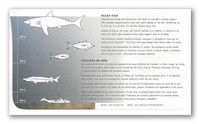
| Name | Value |
|---|---|
| Date of Issue | May 30, 1997 |
| Year | 1997 |
| Quantity | 2,500,000 |
| Denomination |
45¢
|
| Perforation or Dimension | 12.5 x 13 |
| Series | Ocean Water Fish |
| Series Time Span | 1997 |
| Printer | Ashton-Potter Canada Limited. |
| Postal Administration | Canada |
| Condition | Name | Avg Value |
|---|---|---|
|
M-NH-VF
|
Mint - Never Hinged - Very Fine | View price |
|
U-VF
|
Used - Very Fine | View price |



Upon his return to England in 1497, John Cabot reported that fish were so abundant in the waters of North Atlantic (of what is now Newfoundland), one could fold up the nets and retrieve a catch by simply dipping a basket into the sea. By the 16th century, hundreds of ships and thousands of men were drawn by the North American cod and whale fisheries. The fish brought the fleets that resulted in the settlement of Newfoundland and the establishment of numerous villages in the Maritimes. Since then, fishing has remained a vital industry in Canada, and the fish who inhabit our ocean waters have become part of our heritage. Celebrating that heritage, our new Ocean Water Fish stamps celebrate four of the creatures that swim the waters off the Canadian coastline. Collectors will be interested to know that the official first day cover for the Ocean Water Fish stamps will be postmarked in Alberton PEI - the site of the largest great white shark caught in Canadian waters, measuring 5.26 metres in length. Marking a splash on the issue day of May 30, 1997 in a set of four domestic-rate stamps are the great white shark, bluefin tuna, Pacific halibut and Atlantic sturgeon. Ocean enthusiasts of all ages will be impressed with the realism of these stamps. The 1997 Ocean Water Fish stamp design is by Q30 Design Inc. of Toronto, whose earlier stamp work includes the Holocaust stamps and the High Technology stamp set. The selection of the fish was a difficult task but even larger challenge came from the decision to use actual underwater photographs. Although it was extremely difficult to find underwater photographs that were sharp and clear enough to be reproduced in postage stamp size, the design team knew that photography was the best way to convey the qualities of the fish. And the results are stunning. There is no shark more notorious than the great white (Carcharodon carcharias). Found in the warm temperate parts of all oceans, this shark has been recorded in the Atlantic as far north as Hare Bay, Newfoundland and the Gulf of St. Lawrence. Occasionally, great white sharks have been reported in British Columbia waters and even as far north as Alaska. In Canada, the great white appears in warm waters, most frequently in August preferring the water temperatures between 12 and 25oC. Sharks are the modern survivors of an ancient group that was among the first true fish to inhabits primeval seas. They differ from most modern fish in that they have a skeleton of cartilage rather than of bone. Absent also is the swim bladder that other fish have, which means that sharks must move constantly or skin towards the bottom. Although about 340 species of sharks have been catalogued worldwide from the Arctic to the Antarctic, only 36 species occur in Canadian waters. The great white is distinguished from the other related mackerel sharks by its distinctive, strongly serrated, almost triangular-shaped upper-jaw teeth which approach 8 cm in length. Its snout is conical and pointed, hence the shark is sometimes called the white pointer. Despite its name, the great white shark is not white at all, except in very large specimens which are a dull white grey. The back is lead grey, grey brown, slate blue or black and fades to a dirty white on the belly. The pectoral fins (both sides) have black tips while the dorsal (back) and caudal (tail) are dark along their rear edges. The great white lives to be at least 20 years old, while growing to be about six metres in length. Its diet consists of harbour seals, sea lions, harbour porpoises, shell fish, sea turtles, gulls and fish. Many unusual items have been found in the stomachs of these sharks including a whole sheep, a bulldog, a cuckoo clock and bottles and cans.